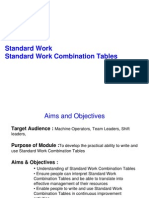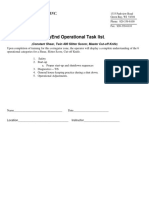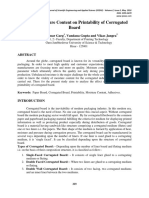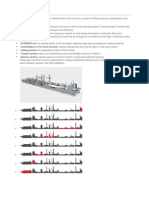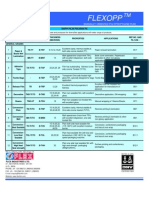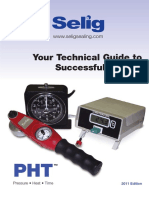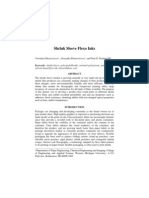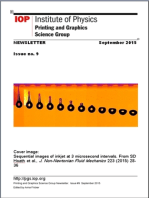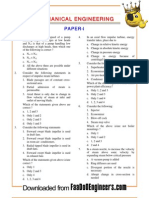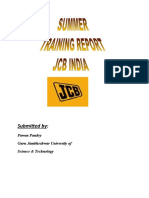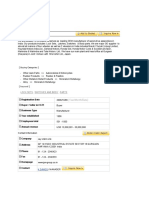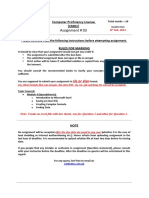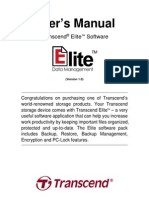IPP Training Report
IPP Training Report
Uploaded by
coolpawan10Copyright:
Available Formats
IPP Training Report
IPP Training Report
Uploaded by
coolpawan10Original Description:
Original Title
Copyright
Available Formats
Share this document
Did you find this document useful?
Is this content inappropriate?
Copyright:
Available Formats
IPP Training Report
IPP Training Report
Uploaded by
coolpawan10Copyright:
Available Formats
Parneet
Department of Printing Technology
0703204
International Printo-Pac Limited
(INDIA)
LIMITED, C-4 to C-11 , Hosiery Complex, Phase-II NOIDA-201305 (U.P.) INDIA
TEL.: +91(0) 120 256 8046 to 256 8051 FAX: +91(0) 120 256 8045 E-mail: ippnoida@ippindia.com
INDUSTRIAL SUMMER TRAINING REPORT Duration Of Training Period:-7 June-2010 to 30 June-2010
Place:- Phase-II Noida Submitted by:Parneet REGN. NO.:-0703204 BATCH:-2007-2011
Department of Printing Technology
Parneet
Department of Printing Technology
0703204
Guru Jambheshwar University of Science & Technology, Hisar (Haryana)
Department of Printing Technology
GURU JAMBHESHWAR UNIVERSITY OF SCIENCE & TECHNOLOGY, Hisar (Haryana)
Acknowledgement
I would like to express my heartiest & sincere thanks to International Print-o-Pac, Noida (INDIA) LTD. for giving me the opportunity to undergo summer training. This report is a result of my efforts in understanding and analyzing the various factors but this report would not have been possible without sincere help and constant encouragement rendered by all the people working in IPP (INDIA) LTD. I would like to pay special regards and thanks to Mr. D.K. Sharma (HR Manager) for his guidance as well as showing his keen interest that helped me in materializing the work. I acknowledge my depth of gratitude to Mr.Dharmender chairman, Department of printing technology, Mr. Pankaj Kumar Tiwari Advisor,Training and placement cell, Associate Prof. Anjan Kumar Baral, incharge, department of printing technology for allowing me to do my training in IPP Press (INDIA) ltd. and for their timely help. My appreciation also extends to the Mr. D.K. Sharma (HR Department), Mr. Vinay Srivastav, Mr.Chetan Parmar,
Parneet
Department of Printing Technology
0703204
supervisors, and all the workers of all the departments in IPP Press (INDIA) Ltd. for helping me in gathering all the information related to the training, which will be of great help to me in future. They provided me with all the valuable and related information about the company.
Introduction
INERNATIONAL PRINT-0-PAC LTD, is one of the Asia's finest printing, packaging and publishing support services organization, is one of the leading commercial press in India. With the production facilities, that reflect the excellence on every front; where technological dexterity, quality of human asset and passion for perfection, continue to deliver high quality with speed, consistency and cost effectiveness every time! It strove to integrate on the value chain of the industry. IPP is a dynamic player in India's fledgling printing & packaging industry. It is equipped with latest technology machines with high speed as to increase up the production. They do not comprise at any stage with related to their quality. Quality printing is considered as must for them. So they are able to produce high production with tremendous quality. IPP has thus attracted the best directors and designers to use the workstations as electronic palettes. The first company in Asia with press technology of MANROLAND with electronic control. IPP has created a printing revolution. Starting with MAN ROLAND 104, 105, 106 for 4/5/6 color. IPP has now consolidated its position in this niche with the MAN ROLAND 708 - thus bringing India first long press with 8 printing units and the capability of printing 8/0 or 4/4 in one single pass. The 8 color technology on 28" x 40" formats is a veritable revolution in
Parneet
Department of Printing Technology
0703204
the industry giving IPP a true global edge. IPP is ready to offer its customers the real service dimensions. It has two plants one at Okhla (New Delhi) and other at Noida. Most of the prepress and plate making work is being done at Noida plant having latest machines like CTP and Image setter. Production is extensively carried out at Noida plant.
Company Profile
INTERNATIONAL PRINT O PAC LTD. Noida, Uttar Pradesh, India Printing Products - Manufacturer, Export / Import, Public. Ltd. Firm Since 0 Circa 1982. International Print-O-Pac (IPP) India started off as a dynamic player in Indias fledgling printing & packaging industry, driven, relentlessly, to integrate well on the value chain of the industry. Over the years, through recurring technology acquisitions, study of new niche markets and augmentation of efficiency at every level of the organization, IPP has undergone a remarkable metamorphosis ? a transformation from just a large print-and-packaging company, into a well integrated, conscientious and cost-effective solutions Circa 2004.IPP is one of Asias finest printing, packaging and publishing support services organizations today, replete with two state-of-the-art production facilities that reflect the excellence of ISO 9001:2000 on every front. Today, IPP epitomizes technological dexterity, high caliber human asset and passion for perfection, as it continues to deliver high
Parneet
Department of Printing Technology
0703204
quality with speed, consistency and cost-effectiveness every time. PRODUCTS:-Manufacturers and Exporters of- PACKAGING (Folding cartons) Mono Cartons Liner Cartons Corrugated cartons Outer Cartons/ Shippers PACK STYLES Interlocked Cartons Crash Lock Cartons Double/ Single Walled Cartons Window Patched Cartons Envelopes Design and Page Production Printing Packaging LabelsOnline die-cutting Foil-stamping Embossing Gumming Waste disposal. BINDING Hard Case Books Soft Cover books Centre Pinned Books Wiro Bound Books Spiral Bound Material Customized Binding FINISHING LINE UV Varnish Aqueous Coating Lamination FoldingGlueing Digital die making and die cutting Foil Stamping Embossing Heat Set Web Health and safety (indoor application, with back-lit translites, vinyl mounted panels, etc.) Retail and window display (indoor - in-shop printed display of various shapes and sizes). Outdoor hoardings, banners, kiosks, road dividers, bus panels, bus shelters, Railway over-bridge signage, etc. TEAM:-
IPP is staffed by more than 500 technically qualified specialists. The company hires its management team from leading management and
Parneet
Department of Printing Technology
0703204
technical institute. The professional on the floor are engineering graduates and diploma holders from the best printing schools and universities within India. IPP recruits trainees for summer programs and courses and follows a rigorous selection procedure while recruiting the candidates for a permanent position. Prior to induction, our new incumbents are provided opportunities to train with our stakeholders and associates and provided regular company-specific training. We regularly transfer candidates between locations and departments to develop all-round potential. We aim to promote from within as a matter of policy
Parneet
Department of Printing Technology
0703204
CONTENTS
(1) CO-ORDINATION DEPARTMENT (2) PRE-PRESS DEPARTMENT (3) PRINTING DEPARTMENT (4) PACKAGING DEPARTMENT (5) BINDING DEPARTMENT (6) WEB OFFSET (7) UV. & SCREEN PRINTING
Parneet
Department of Printing Technology
0703204
Department of Printing Technology Guru Jambheshwar University Sc. & Tech, Hisar
Coordination department
The role of the planning department is to coordinate the whole work flow of the press in such a way that the product provided must be prudential and economical in each and i.e. quality, time money or machine utilization. The job of this department is also termed as planning. Planning means to plan for requisite job in an effective manner so that we get the job executed in a proper manner and the final products quality should be as desired. IPP has vast coordination department. A coordinator communicate between the customer & the employee. They are the main key between the above said. This department works as to give every information about costing, data, infrastructure related to the particular job. They are capable to find out the estimation cost of the job before and after completion the final output. The proof is once taken it is than send to the coordinator which finds out the estimated price of a single page considering the task being done on that particular sheet like
Parneet
Department of Printing Technology
0703204
varnishing, lamination etc and thus it is open to the client and staff about the estimation cost. This department is responsible for all the maintenance work required for strong of records of all the jobs running jobs, future job orders. This department also has the responsibility of communication with clients and receiving their message about required things i.e. it acts not only as co-ordination department but as Public Relation Office for firm.
PRE-PRESS DEPARTMENT
Pre-Press Department
The working in any press started from pre-press section. The page is being prepared in advance through different operations in this department through Mac software's and IBM PC so that page can be seen clearly on computer screen and after that a client can see through digital printers or through EPSON etc prior to printing or proofing. Hence a hold is being perfectly made on print quality, size, colors etc. High end scanners, systems, image-setters and power Macs complement the Dolev 800 for generating large format output. The detail of this section is given below:-
Parneet
Department of Printing Technology
0703204
DESIGNING ROOM :Designing is the soul of printing & packaging. Designer should have knowledge of printing i.e. gripper margin, print area, and color planning. Generally designer concentrate on the creativity then printing job as problem occur while printing such as smaller text matter in reverse color, picture quality & resolution etc. In this section designer receive the job in digitally or in form of the PDF file. In this section, job which is sent by the client is made for editing and modification. The software used in this apartment is adobe in design, Adobe illustrator, pit shop, Adobe Photoshop, Quark x press and freehand. Designer should always give an EPS & PDF for printing to acquire the print quality. The different software is used for different job of printing. The Adobe illustrator is mainly used for purpose of packaging job, designing, labels and sticker etc. The Adobe Photoshop is image editing software which is based on the pixels. It is mainly used for color correction & picture quality. The Adobe in design is used for the job of book work. Adobe acrobat 7.0 professional (Pitshop) is used for PDF file (portable documents format).
MAC OPERTION:-This is the section where all the processing
related to particular job is carried out, whether to crop or changes to made etc. are some common tasks which has to be done. For these purposes different software is used which enhances the productivity of the job to be done. These operations and changes are made as per standards or client requirements. Thus after all these changes a complete page is prepared at the end. These pages are further sent to plate making section.
The color used for printing is CMYK (cyan, magenta, yellow, black) which is known as the process color. Many times a special color (pantone) is used for the purpose of color matching.
Parneet
Department of Printing Technology
0703204
Pre-Press Equipments:1. Scitex electronic image system with 3 work station viz.
prismagic, blaze 98 and prisma with range of power mac and power pcs capable of processing all kinds of data. 2. ICG370HS vertical drum scanner with copy-dot option. The input is 320*476mm.
3. Scitex
eversmart flatbed scanner whose input size is 260*445mm. 4. Dolev 800V image-setter with Brisque impose and online- Rite 8600S screen CTP with online Hasse plate processor.The output is 838*1176mm. 5. Creo CTP Trendsetter Quantum 800(CTP). 6. Plate processor & baking unit. 7. Esko work flow (deskpack, artios cade, flexrip, fast impose, golden retriever for archival. 8. Kongsberg XE10 sample maker. 9. Roland and Encad digital printer and whose width is 1270mm. 10. Dianippon, Dupont and FPX85 pre-sensitized plate processor & plate width is 711*1016mm. 11. Fag proofing process (two) & sheet size is 508*711.2mm. 12. Dianippon proof press KF 124GI & sheet size is 762*1016mm. 13. Epson 9800 digital proofer with star rip & width is 914mm. 14. Gretag color management system. 15. Register optical plate punch. 16. Spectro lino. 17. Spectro scan. 18. Spectro eye. 19. Densitometer (film). 20. Color Densitometer (paper).
Parneet
Department of Printing Technology
0703204
Raster Image Processor Station (RIP):-The
raster image processor converts various types of digital data to machine bitmap understood by the recorder to which it is attached. Before imposition, RIPing is done. Riping is process in which continuous tone dots convert into half tone dots. The job is sent from the designing room in form of the PS, EPS & PDF. It convert PS, EPS & PDF (called riping format) into half-tone dots. The elliptical dots are used for printing in IPP.
IMPOSITION:- After riping of job ( convert into half-tone dots), job is sent for Process of imposition. Imposition mean the proper page layout or proper pagination of page. Imposition refer to placing image in the correct position on printing plate so they print in the desired location on the final printed sheet. IMPOSITION SOFTWARES :-There are three imposition software that are used in plate making which are given below : Esko Creo Screen ESKO:-The software used in this server is Back Stage 7.0 Pilot. In this section we do the planning and layout of job so that paper wastage is minimum. In this a special software is used which is known as Fast Impose. It used for the line work and continuous tone and in last stage of processing 1 bit TIFF (tagged image file format) is formed.
CREO:-It is the imposition software which is also used in planning and pagination of job. A special software Preps 5.0 is used in the creo. SCREEN:-The software used in this server is Pixel Stream 5.3. The entire clients file which comes from the planning department is stored in it. In this a special software is used which differentiate the clients file along with cover file as well as inside section file. This software is called HQ-510 PC.
Parneet
Department of Printing Technology
0703204
Types of Imposition:(1)One side imposition:-In one side imposition, one printing plate is used to print on one side of the sheet as it passes through the printing press. (2)Sheet-wise Imposition:-Two printing plate are used in sheet-wise imposition. One printing plate is used to printon side of a press sheet . A second plate containing different information is then made, the sheets are turned over, and the sheets are printed on the other side from the second plate. (3)Work-and-Turn Imposition:-Work and turn imposition employs one printing plate to print on both sides of a single of paper. The sheet is first printed on one side, the pile is turned over, and the sheet is fed through the press again with the same lead edge. (4)Work-and-Tumble Imposition:-Work and tumble imposition also use one plate to print on both side of one piece of paper. On the second pass through the press, the pile is tumbled so that opposite edge enter the press first. The basic requirement for imposition are : Size of job. Machine size Paper size + binding. Care to taken PDF work flow: Check for image with image mode (should be CMYK). Check for resolution (should be 300 DPI) Job margin (equal in all side).
Parneet
Department of Printing Technology
0703204
Check for font.
Digital Proofing :-Digital proofing involves sending files electronically from a scanner or printer directly to a proofing mechanism that make a color proof from the digitized information. The many categories of digital proofing encompass design comps, revision approval, imposition dummies, and final contract proofs. One dividing line that can be drawn is between those that produce a continuous tone image and digital proofing system that simulate the actual halftone dot of the to be printed on press.
EPSON PROOF:-The Epson proof is mainly used for the purpose of the color reference. It is used for checking of color density. Blue Print(Ferro):- For photomechanical proofing in monochrome, blue print is exposed to arc light together with negatives, in most cases a stripped flat in a vacuum printing frame. The result is photomechanical positive showing the image areas in dark blue on a more or less white or light blue background.
Blue print give sufficient information on three aspect of accuracy, that of the assembled material its position as well as of the imposition. As the fourth kind of accuracy with which proofing is concerned namely the accuracy of internal register or fit blue prints may or may not be sufficient indicative. Of these blue prints a dummy is prepared thoroughly checked and the approval is taken from the client. This is necessary before production process. Paper Coating : It is of diazo type Development : By Ammonia Vapour
EDITING
Deletion Used : Orthophosphoric acid (Technova) Plate Cleaner : Technova
Parneet
Department of Printing Technology
0703204
Editing on plate is done by checking visually. Plate is kept over slanting table and cheek thoroughly for broken text matter, over/under exposed, unwanted image area, spots, marks, scratches etc.
TRAPPING :-In printing there is possibility of gaps or incorrect overlap of color due to misregistration while the job is being run on the press. There can be misregistration due to stretching and inherent flexibility of the substrate as it moves through the press. The technique of trapping seeks to reduce this possibility by either enlargement the background or foreground color slightly to compensate for possibility of gaps between adjacent color.
Trapping was once exclusively handled by the pre-press or printing facility because they were responsible for creation of film or producing color separations.
CTP PLATES:The Pre-sensitized coated Plate is used for CTP ( computer to plate). Pre-sensitized coated Plate(PS):These plates are made of Aluminium which are coated by the light sensitive emulsion. The Technova plates are used by the IPP Pvt. LTD. Light Sensitive Plate:The light sensitive materials are those material which are undergone with chemical change by the action of light is known as light sensitive material. The plate as the name says are sensitive toward light action. They are exposed through the laser light beam. Plate size:For sheet fed:(1) 510*665mm
Parneet
Department of Printing Technology
0703204
(2) (3) For web-fed:-
530*665mm 785*1040mm
(1)602*975mm (2)585*1000mm
PLATE MAKING BY CTP:EXPOSING UNIT:-After receiving the command from the computer, ( Esko, creo & screen) the plate is send to exposing unit. The plate is exposed by the laser light. The laser light produced the image which is in latent form. Screen (Plate Rite 8600s) is used for the purpose of exposing, about 22 plates/hour are exposed by this unit. DEVELOPER:-After exposing the plate, the plate is sent for development. In this process the image areas are left and the non-image areas are washed out. The chemical used for the development is Stardust +. BAKING OVEN:- In this process the plate is heated about two minute and the temperature range is about 265C-267C. After heating the plate, the image areas which are present on the plate run for long time. RINISING & GUMMING M/C:- After heating of plate, the plate is sent automatically in rinsing & gumming unit. In this unit the plate is washed and for gumming, the Unifin gum is used. The purpose of gumming is to protect the plate surface.
REGISTRATION M/C:Operation procedure:Step 1:-
Parneet
Department of Printing Technology
0703204
Set all micro- adjuster to zero o position. Step 2: Loose 4 black head screws Choose the stopper to fit plate size(1040, 975, 745). Select switch to punch(780,425 or 700). Step 3: Feed the first plate to proper location. Move two CCD to search the cross-line + approximate location and lock two side screw and CCD micro-adjuster screws. Hold plate with 2 finger against the right stopper and two front micro-adjusters. Using two front micro-adjuster screw to adjust the horizontal line. Using two CCD micro-adjuster screw to adjust vertical line. Step 4: After all register, then punch and pull out plate. Step 5:Feed the 2nd plate to proper location. Do not touch and move CCD anyhow.
Hold plate with 2 finger against the right stopper and two front micro-adjuster. Using two front micro-adjuster to adjust horizontal line. Using right side micro-adjuster to adjust vertical line. After all are registered, then punch and pull out plate. Step 6: According to step 5 to adjust and punch the rest plates of same set. Step 7: Set all micro-adjuster to zero 0 position.
OUTPUTTING OR OUTPUT TO FILM:-
Parneet
Department of Printing Technology
0703204
The outputting is obtained through the image setter. Image-setter also allow for outputting of certain types of plate material, such as polyester. The term image-setter is used to describe an output device that record processed data to photographic paper, film, or plate material. There are three major components which is used for producing the film from computer data. RIP software Image-setter Film processor RIP software:-Rip software is used to convert the continuous tone dots into half-tone dots. IMAGESETTER:-Image-setter exposes the single color, spot color & process color separations on a light-sensitive substrate. Image-setter can offer a range of resolution up to +_3,000 dpi. The half-tone ruling screen of 133 to 150 lpi is used. FILM PROCESSOR:- The film processor develops , fixes, washes, and dries exposed light-sensitives output from the image-setter. A processor with adequate developer storage and control is necessary to produce film positives with maximum density. PLATE MAKING BY MANUAL:EXPOSING Unit:- The film positive emulsion side which is obtained from film processor is pasted with the plate emulsion side. The light is drawn to plate for exposing. These are exposed about 200 to 250 second. DEVELOPER:- After exposing the plate, then development is done. For developing the plate the Technova chemical is used. In this process the image areas are left and non-image areas washed away. WASHING:- After developing the plates, the plates are washed by hot water. DELETE & GUMMING:- After washing the plate, if there is any mark on the plate then delete & gum is used.
Parneet
Department of Printing Technology
0703204
QUALITY CHECKING:(1)DIGITAL WEIGHTING BALANCE:- Digital weighting balance is used to find the weight of paper and board. For paper we take the size 10*10cm for measuring the weight. For board we take size 20*25cm and multiply with 2, for measuring the weight. (2)DIGITAL THICKNESS GAUGE:- This instrument is used to measure the thickness of the paper and board in micron. The lowest reading will be considered. (3)STIFFNESS TESTER:- It is used to measure the stiffness of the board. Always machine direction is greater than cross direction. Mathematically:Stiffness=( 1st reading in left + 2nd reading in right )*5 2 MD>CD (4)BUSTING STRENGTH TESTER:- This instrument is used to measure the busting strength of paper and board in both side (front and back).
(5) OVEN:- Oven is used for heat testing of cartons. Oven is heat
up to the 80C for one hour. It is used for checking of the shrinkage, pipelines and wrinkles.
Parneet
Department of Printing Technology
0703204
(6)DIGITAL TENSILE MACHINE:- Digital tensile machine is used to measure the adhere strength between two films. (7)DYNE SOLUTION:-Dyne solution is used to calculate the surface energy of the film(any type). It is mixture of the form amide and cellusolve. FORD CUP:- Ford cup is used to check the viscosity. TEMPLATE:- The instrument by which we cut the required size of the paper. COMPRESSION STRENGTH TESTER:- It is used to measure the force where carton or box rupture, reading will be noted and multiply with 20 and we will get the total compression strength. SHADE CARD:-It is mainly three type:1. light shade 2. standard shade 3. dark shade. UNIVERSAL INDICATOR:- Universal indicator is used to measure the pH.
INK KITCHEN:PROPERTIES OF INK:-Three properties of ink that control the ease and quality of image transfer are viscosity, tack, and drying quality. VISCOSITY:- The term viscosity is used to describe the body of ink accurately. Some inks are thick and heavy (offset & letterpress inks), and some are fluid and light. TACK:- Tack is property of the ink which is used to control the transfer images. Each successive run should be printed with ink of less tack.
Parneet
Department of Printing Technology
0703204
INGREDIENT IN INK:-(1) Pigment:- the pigment is dry particles that give the color to ink. (2) Vehicle:- The vehicle is the fluid that carries the pigment and cause it to adhere to the substrate. (3)ADDITIVES:-Additives control the ink characteristics such as tack, workability, and drying quality. SPECTROPHOTOMETER:- Spectrophotometer is used to scan the printing. Spectrophotometer setting:1. 2. 3. 4. 5. 6. 7. 8.
color space physical filter white space illuminant Observer angle Tolerance Ratio Density standard
: l*a*b : No : auto : D50 Degree K : 10 degree : Delta E CMC : 2:1 : Ansi T
Parneet
Department of Printing Technology
0703204
PRINTING DEPARTMENT
Parneet
Department of Printing Technology
0703204
Printing Section
The printing section is the heart of the printing press. It is the basis of any job to be carried out since we are concerned with printing. The printing section in any press is most centrally located, so that departments and so it is in IPP Press. It comprises a veritable fleet of sheet fed Colour machines, including the single, double, four, five, six and eight colour offset presses from the global leader Man Roland. The printing section is the heart of any press. Its position should be such that it can easily access to all others departments. Air conditioning is must for good quality printing. IPP satisfies most of the conditions of good pressroom. IPP provides an array of ROLAND 4,5,6, and 8 colors units allow you economies of scale and choice. These optimize time and cost benefits for clients with international productivity standards. in four/five/six/eight colors. Here clients can also have the choice of running special colors along with a 4 color run using the 5 color or 8 color Man Roland machines. The sterile environment and the international quality of inputs give a uniform quality even on through out speeds of up to 15000 per hour. Now Solona C96 Machines are available which have maximum speed of up to 29000 per hour and KOMORI 38S is latest machine which have speed up to 42000 per hour. Printing can be carried out (using offset principle) by the following ways:A detailed study of completed automatic feeding unit may be divided into the following groups:-
Parneet
Department of Printing Technology
0703204
1. Sheet board Separation 3. Sheet Lifting &Forwarding Controls 5. 1. Sheet Resister Pile Board :
2. 4.
Sheet Sheet
It is also called feed board end of the machine. The Printing sheets are placed on its surface after proper jogging. The different part of sheet board as under: a) Front Stopper b) d) Side Stopper Side Adjusting
c) Back Stopper Screw
2.
Sheet separtion
In modern sheet fed offset machines, only the back sap ration system of automatic feeding is used. Sheet are forwarded streamly &overlapping each other in this process. The main part of this automatic feeder is its Air sucking system. Suckers separate and lift only one sheet from top of the paper pile. Main Parts: a) Air Blower Blower Foot
3. Sheet lifting & forwarding:
b)
Brushes
c)
The lifting &forwarding of the separated sheet from the pile of the paper is done by two sets of feeding unit. Two rubber piles coming from the compression unit are joined with the lifting &forwarding suckers.
Parneet
Department of Printing Technology
0703204
b. Lifting Suckers : Large size of machines has four lifting suckers which are lifted side by side. Both the suckers have metallic nozzles and each nozzle is covered with rubber suckers. C Forwarding Sucker : There are two suckers which are similar to lifting sucker. They forward the sheet so that the front edge of the sheet comes between the introduction roller & guide wheel.
4.
Sheet controls : From guide wheel up to front lays there are several parts to transport the sheet all these parts are called sheet controls and described as under: a) C) 5. Guide Wheel End less Tape b) d) Bosses Sheet Detectors
Sheet register : The term sheet register normally denotes the position of the printed image on the sheet. Here, only sheet of paper is prepared to get correct register in printing. Now a days three point lays system is used. Two of the points are in front and one is at the side.
a. Front Lays:
These are two or four in numbers, fitted at the edge in balancing position of the larger side of the sheet.
b. Side Lays:
Parneet
Department of Printing Technology
0703204
The side edge is registered by the side lay. There are only two in machine. They are on operator & gear side.
PRINTING UNIT:
In printing unit there is three main cylinder :1. Plate Cylinder
2. Blanket Cylinder 3. Impression cylinder
Plate Cylinder:
* To hold the printing plate tightly in register.
* To make the plate in contact with dampening and inking roller. * To transfer the image on the blanket cylinder.
* At the edge of the plate cylinder, a hard metal ring is attach to the cylinder body which is known as bearer. * The body of the plate is similar to the diameter of the bearer. This difference is known as undercut. * There is a gap in plate cylinder to tight the plate which is called cylinder gap.
2.
Blanket cylinder:
It carries the printing blanket in contact with the inked image on the plate cylinder & transfers the image to the paper to the paper. The distance between plate cylinder &blanket cylinder can be adjusted. The blanket cylinder is driven through the gears fitted at its both ends similar to the plate
Parneet
Department of Printing Technology
0703204
cylinder. Both ends its recessed part have bearers. The contact of bearer is set along the bearers of other cylinders.
3. Impression Cylinder:
It carries the paper into the printing unit and contact pressure from the blanket cylinder and transfer to the delivery gripper. The body of cylinder is not undercut. It has even steel surface. The cylinder revolves in parallel position along with the blanket cylinder through its bearer contact. The cylinder gripper must securely hold the web during printing operation to avoid problem register and tonal value.
MAN ROLAND 708 MACHINE:For R-8 M/C:(1)Keep the plate on each station inside the given slot. (2)Feed the automatic plate loading (APL) program in the control panel. (3)Switch on the m/c for loading and unloading of plate and ensure that the loading indicators are showing the correct positioning of plate. (4)Set the feeder. (5)Pour the ink inside the tray at all station to be used, charge ink on roller. (6) Check the conductivity of water and alcohol % to ensure that it must be between 500 to 1000 and 3.0% to 6% respectively and add fountain solution accordingly. (7)Run the machine for few sheet and check the registration, shade, matter, keyline etc and ensure that all other quality parameter are perfectly OK, otherwise take suitable corrective action. (8)Run the machine for 150-200 sheet to check once again for all the quality parameter if the quality is satisfactory, store the program on central control consol. INSTALLING SEQUENCE:-
Parneet
Department of Printing Technology
0703204
The rollers are installed in reverse sequence. The rollers identified in the illustration with dark shading are installed permanently.
TECHNICAL SPECIFICATIONS
Measure in mm
IMPRESSION SHEET:IMPRESSION SHEET SIZE MAX/MIN. MAX MIN PRINTING AREA MAX EDGE OF SHEET TO LEADING MAX EDGE MIN SHEET THICKNESS MAX MIN SHEET OUTPUT MAX STANDARD 740*1040mm 340*780mm 715*1020mm 12 10 1.0 0.04 15000/hour
PRINTING PLATE:PRINTING PLATE SIZE PACKING SHEET PLATE THICKNESS PLATE FRONT EDGE TO LEADING EDGE PLATE CYLINDER UNDERCUT PLATE CYLINDER STANDARD 1030*785mm 1030*755mm 0.3-0.5mm 43 0.5 300
BLANKET:BLANKET SIZE PACKING SHEET STANDARD 1060*910mm 1030*755mm
Parneet
Department of Printing Technology 1030*765mm 1.90 2.60 300
0703204
TOP SHEET BLANKET THICKNESS BLANKET CYLINDER UNDERCUT BLANKET CYLINDER
For R-4,5,6 Machine:(1) keep the plate on each station. (2) Unload the plates of previous job from all fire station. (3) Switch on m/c for loading of plates. (4)Set the feeder. (5)Pour the ink inside the tray at all station to be used, charge ink on roller. (6)Check the conductivity of water and alcohol % to ensure that it must be between 500 to 1000 and 3.0% to 6% respectively and add fountain solution accordingly. (7)Run the machine for few sheet and check the registration, shade, matter, keyline etc and ensure that all other quality parameter are perfectly OK, otherwise take suitable corrective action. (8)Run the machine for 150-200 sheet to check once again for all the quality parameter if the quality is satisfactory, store the program on central control consol.
MAN ROLAND-706 M/C:- Man Roland-706 is six color machine,
(cyan, magenta, yellow, black + white + clients requirement color). The construction of this machine is given below:1. Infeed unit - The pile of sheets is placed manually. 2. Lifting sucker & forwarding sucker:-These suckers to lift the 3. 4. 5. 6. 7.
sheet and to forward to the conveyor belt. Conveyor belts - These allow the sheets to enter into the printing unit one by one. Side Lays: - The side edge is registered by the side lay. There are only two in machine. They are on operator & gear side. Front lays:- These are two or four in numbers, fitted at the edge in balancing position of the larger side of the sheet. Printing unit Six color printing can be done by this machine. UV & varnish unit - uv and varnish can be done online to give
Parneet
Department of Printing Technology
0703204
glossy effect to the printed sheets.
8. Drier - this is provided with the UV lamps and infrared bulbs to dry
the ink.
9. Outfeed unit - After printing and drying the printed sheets are
outfeeded with the help of grippers.
DESCRIPTION OF MACHINES R-6, R-5, R-4 MAN ROLAND MACHINE WITH RCI: (6 Color, 5 Color and 4 Color machines)
Paper Size 18.89" * 26" (max.) 8.25" * 11" (min.) Plate Undercut Plate Thickness Packing 0.5 0.28
0.32-0.34 2.25 1.95
Blanket Undercut Blanket Thickness Packing 0.3
Fountain Solution Alcohol % Conductivity
@ 3% (1200 ml)
3%-6% 500 us-1000 us Conventional
Dampening System
R-6 MAN ROLAND has Drier in it.
SIZE OF PLATE, PAPER AND PRINT AREA
Parneet
Department of Printing Technology
0703204
R-708:Plate size Max. paper Mini paper Max print area R-7061st Plate size Max. paper Min. paper Max. print area R-706 2nd Plate size Max. paper Mini. Paper Max print area R-705:Plate size Max paper Min. paper Max print area R-500:Plate size Max. paper Mini. Paper Maxi. Print area R-104:Plate size Max. paper Mini. Paper Max. print area R-106:Plate size Max paper
: : : : : ; : : : : : : : : : : : : : : : : : : : :
1040*785mm 1040*740mm 480*340mm 1020*710mm 1040*785mm 1040*740 480*340mm 1020*710mm 1040*785mm 1040*740mm 480*340mm 1020*710mm 1040*785mm 1040*740mm 480*340mm 1020*710mm 745*660mm 740*580mm 400*260mm 730*570mm 665*510mm 660*480mm 279*209mm 645*455mm 665*510mm 660*480mm
Parneet
Department of Printing Technology
0703204
Mini. Paper Max. print area DOMINAT:Plate size Maxi. Paper Mini paper Max print area R-2:Plate size Maxi. Paper Max print area P-2:Plate size Maxi. Paper Max print area M-2:Plate size Maxi. Paper Mini paper Max print area
: : : : : : : : : : : : : : : :
279*209mm 645*455mm 665*530mm 660*475mm 292*292mm 645*455mm 1030*820mm 1020*750mm 1020*710mm 1030*820mm 1020*740mm 1020*710mm 1130*930mm 1120*820mm 760*540mm 110*760mm
Parneet
Department of Printing Technology
0703204
WEB OFFSET DEPARTME NT
Parneet
Department of Printing Technology
0703204
SOLANA WEB FED OFFSET (C-96):Solana web fed (c-96) is four color perfection machine i.e. both sides of printing can be done. This web fed machine has very high speed up to 29000 per hour. The construction detail of this machine is given below:1. Roll Stand :- The roll stand holds one or two webs of paper, and it meters the paper feed into the press. Control of the web as it unwinds from the roll stand and enters the printing unit is established by a dancer roller which operates with a conjunction with a brake on the roll stand. The dancer is free to move up and down. In addition to the dancer roller, it is common for a roll stand to include a splicer, sometimes called a paster. 2. Infeed Unit :- Paper is delivered to the press by the infeed section. The infeed section typically contains a web steering device which controls the side lay and a tensioner which maintains the proper tension on the web as it enters the press. 3. Printing :- The printing section is made of four printing units. Each printing unit contains one or more printing couples. A printing couple contains an inking system, a dampening system, a plate cylinder, and a blanket cylinder. Each printing couple can print one color of ink. 4. Dryer and Chiller :- The dryer and chiller works together to ensure that the ink on the printed sheet is dry and set as it comes off the web. The temperature of drying unit is about 150 C. This temperature is high enough to evaporate most of the ink solvent. Drying is immediately followed by chilling, which is accomplished by passing the web over a series of water cooled chill rolls. During chilling the web temperature is reduced, which is cool enough to set the binder and pigment. 5. Silicon Applicator :- Silicon applicator is used in Solna web printing machine to give glossy look to the paper. 6. Folding and Cutting :- Folding and cutting units are used to fold and cut the paper. In Solna web printing machine, there are three types of basic folders: former folders, jaw folders and chopper folders. A
Parneet
Department of Printing Technology
0703204
former folder folds the web by pulling over a triangular-shaped former board along its length. A jaw folder folds the paper the web across its width by allowing it to travel around a cylinder equipped with a tucker blade which forces the paper into a jaw on an opposing cylinder. After passing through the folding jaw, the web is automatically cut into the individual signatures and, if necessary, passed to a chopper folder. In the chopper folder each signature is forced between two rotating fold rollers that make the final fold. 7. Delivery Unit :- The delivery section contains a rewinder which winds the web into a roll for later processing.
KOMORI WEB FED OFFSET (38-S):KOMORI Web fed offset is latest four color printing machine. This web fed machine is also called perfector machine because printing is done in between blanket to blanket cylinder, these cylinder act as impression to each other. This machine has very high speed up to 42000 per hour. The construction detail of the machine is given below:1. Roll Stand :- The roll stand holds one or two webs of paper, and it meters the paper feed into the press. Control of the web as it unwinds from the roll stand and enters the printing unit is established by a dancer roller which operates with a conjunction with a brake on the roll stand. The dancer is free to move up and down. In addition to the dancer roller, it is common for a roll stand to include a splicer, sometimes called a paster. The reel width is 950mm. 2. Infeed Unit :- Paper is delivered to the press by the infeed section. The infeed section typically contains a web steering device which controls the side lay and a tensioner which maintains the proper tension on the web as it enters the press. 3. Printing :- The printing section is made of four printing units. Each printing unit contains one or more printing couples. A printing couple contains an inking system, a dampening system, a plate cylinder, and a blanket cylinder. Each printing couple can print one color of ink. The sequence of the printing units are black-cyan-magenta-yellow.
Parneet
Department of Printing Technology
0703204
4. Buzzle wheel:- These buzzle wheel are used for checking of registration. 5. Dryers:- Dryers are used to dry the papers. The temperature of the dryers are kept up to 200-250C. 6.Chiller:- Chiller is used for cooling. It cool the heated paper which comes from the dryers and it will kept at 17-18C. Silicon act as chiller which produce gloss & reduce static electricity. 7. Folding & Cutting:- These are used to fold and cut the papers. In Komori web fed printing machine, there are four basic folders: former fold-jaw folder(tabloid)-quarter fold-double parallel fold.
8. Delivery Unit :- The delivery section contains a rewinder which winds the web into a roll for later processing.
winkler & dunnebier envelope making machine:It is the state of art facility that can produce high quality high volume mailers. 1. Feeding Unit :- The feeder unit for an envelope making machine must separate the bottom sheet of the paper from the infeed pile, pick it up, and deliver it to transfer cylinder. 2. Printing Unit :- In this machine Flexo printing unit is used. It consists of Applicator, plate cylinder, and impression cylinder. Anilox roller and doctor blade assembly is called as Applicator. 3. Scoring Unit :- It consists of vertical scoring rollers and horizontal scoring knife. 4. Window Cutting Unit :- In this unit, window cutting knife cuts the paper as per requirement. 5. Window Patching Unit :- In this unit, glue apply on the window and pasting in the paper.
Parneet
Department of Printing Technology
0703204
6. Folding Unit :- In this unit, side flaps are folding in the creasing mark. 7. Side Flap Gumming Unit :- After holding, side flap is applied glue by two methods: dynatec method, and rotating method. Dynatec method used for normal envelopes and pockets. Rotating methods used for diamond shape envelopes. 8. Bottom Flap Folding Unit :- In this unit, bottom flaps are folded by vacuum cylinders. 9. Remoisturable Unit :- After staggering remoisturable gumming rollers applied glue on the envelopes, it is dried by driers. 10. Peel and Seal Section :- Eclipes system used in this section. Silicon roll passing through gluing unit, the required glue applied on the silicon paper, after gluing it is cut by cutting knife and this flap is carry by vacuum cylinder and pasted in the particular area.
PACKAGING
Parneet
Department of Printing Technology
0703204
DEPATMENT
Packaging Department
DESCRIPTION OF ACTIVITIES: Depending of the type of jobs some/all of the under maintained activities are involved: Cutting & Trimming Varnishing & UV Coating Lamination Die Making & Die Cutting Packaging Corrugation and Pasting Liner Pasting
Parneet
Department of Printing Technology
0703204
Folding and Glueing
Production incharge receives job ticket from production planning along with printing schedule. He then obtain required material from the stores and proceeds with ptg. Job. After printing, it is passed for execution of other activities as per job ticket.
Die Cutting Unit: Die is loaded on unit bed with back up Bakelite plate below. The back up plate is raised to the level of the die-blade with substrate in between and the cutting takes place. The cutting is registered without cutting of release paper to the design of printing with registration mechanism in the unit. Gradually after fine tuning the machine, the speed is increased to optimum level. Finally the printed sample is taken out and sent for customer approval the job is taken out in bulk production.
DIE CUTTING MACHINE:DIE CUTTING MACHINE : In this machine the whole of the sheets are cut into desired shape with the help of the die. The machines available for sheet die cutting are:(1) BOBST sp evoline 102:-It is used for both die cutting of corrugation
and board. Maxi cutting area is 725*1050mm.
Parneet
Department of Printing Technology
0703204
(2)BOBST sp evoline 104 E with separate:- This machine is used for die cutting for board and lamination can be done. (3) BOBST sp eria -106E :-This machine is used for cutting of both board and corrugation . This machine can also be used for the purpose of the lamination and varnishing. It has speed up to 55007200/h.
Constructive details of Die cutting machine 1 Infeed unit 2 Lifting sucker & Forward sucker And double setting 3 Die cutting unit 4 Delivery unit 1 Infeed unit : Sheets are infeeded manually in both of the machines. 2 Lifting sucker & forward sucker And Double setting : The sheets are picked by lifting suckers and transfer to the picker by forward sucker which plucks the sheet and sends to the die cutting unit 3 Die cutting unit : It is the most technical part of the machine. It does the following functions: cutting creasing - It is done by sharp blades present on die board - It is done by the blunt blades resulting in easy folding.
embossing - It is done by placing raised part on the die board
4 Delivery unit: this unit is just before the output unit and removes the waste part from the cut sheets.
Parneet
Department of Printing Technology
0703204
DIE-Braking area:- The area where waste part of the die-cut sheets are removed manually.
Folding machine:Folding machines : This machine is used to fold die cut products. Folding machine has the operation sequence:Prefolding-Glue-flap folding-Hook-Helical guide-final folding-Glue tank(apply on side)-Glue nozzle-Delivery
Block diagram of folding machine:1 Infeed unit : In this the sheets are infeeded manually. The runners and the belts in the machine takes the sheet one by one to the folding part. 2 Folding unit : This unit provides gluing and folding of the infeeded stock at different required parts with the help of knife and runners.
3 Heater : This unit applies heat and pressure to stick the gummed part. 4 Output unit : The belts bring the job from the heaters to the table which is then manually put into corrugated box.
Parneet
Department of Printing Technology
0703204
Automatic Laminating Machine(Steinemann): This machine is used to put a coat of lamination film over printed papers or boards as per customers requirements. This process not only increases the life of the printed product by also gives it on extra glossy appearance which makes it look attractive.
OPERTION:(1)Load the film roll on the shaft in the unwind section after adjusting the position of the sheet to be laminated on the feeding table by adjusting the side lever. (2) If the job is to be stripped laminated, number of film roll require are loaded on different unwinding shaft in such a way that the film is located exactly in the area require. (3)Switch on the machine & take threading through the rollers between coating & impression rollers, upto the winding station & wind few meter over the core. (4) Adhesive mixing (1ltr water added into 20 Kg adhesive) stir the mix for 5-7 minutes & leave for 15 minutes before pouring into the tray, ensure proper flow (viscosity) of adhesive. Check the exact quality of adhesive. (5) Allow the applicator roller to move & adjust the thickness of the adhesive by adjusting the gap between the impression & coating roller, being down impression roller with film & check the adhesive deposited on film. (6) Start feeding the sheet to be laminated from the feeding table manually ensuring that the sheet touches the side lay fixed. Simultaneously, bring down the applicator pressure roll so that the film could get stick the sheet.
Parneet
Department of Printing Technology
0703204
(7)Adjust the pressure & web tension suitably so that the film laminated is free from the wrinkles. (8) After completion of job, identify each pallet as per pile card F0, detailing the date & shift, job No. quantity etc. once the job is finished all the pallet are sent to the next process & fills up the production job ticket.
Liner machine (H & S):Liner machine is basically used for giving internal packing to the jobs related to eatable items and also used for providing transparent window in special jobs. The maximum speed of the this machine is 24000 per hour. The construction details are given below:(1) Infeed unit:- It consist of two section, one unit contains monocartons and other unit consist of the metallise roll through which fed the reel into the former fold. (2) Steel roll:- It consist of the steel which is contact with the glue. (3) Heater:- It is used for purpose of the heating the poly so that poly stick to each other. The range of the temperature is 130C-190C. (4) Cutting cylinder : The film rolled on the winder rolls over the cutting cylinder where it is cut into the required size and transferred to vacuum cylinder. (5) Vacuum cylinder : This consists of vacuum in it which takes the cut window and automatically leaves in the correct position above the die cut product. (6) Sensor:- Sensor is important part of the machine, it is used for the purpose of the counting and to prevent the glue paste on unwanted place of the sheet. LINER SPECIFICATION:=508mm Maxi. =190mm Mini.
Parneet
Department of Printing Technology
0703204
Automatic UV M/C:-
The automatic UV machine is used for UV coating. The UV coating produces shining in the sheet and to prevent the scuffing problem. The construction detail of the machine is given below:Sheet Board:- The sheets are placed on the sheet board manually. Lifting sucker & forwarding sucker:- The lifting sucker is used to suck the paper or lift the paper after then transfer the sheets by forwarding sucker to the runner wheel. Side lays & front lays:- Side lays and front lays is used to maintain the exact position of the sheets. Gripper:- Gripper is used for purpose of the holding the sheet and transfer to center cylinder.
UV Unit:- The UV unit consist of many parts which are given
below: Centre cylinder Blanket cylinder UV (chemical) Steel roll (which transfer 2gm fix amount of ink to rubber roll and produce shining) Rubber roll Sensors (sensor is used to detect sheet in proper position and if sheet is not in proper position then it stop the UV lamps) UV Lamps:- There are two UV lamps, each has 11000 watt . These are used to dry the sheets. Blower:- Blower is used to remove the gas UV unit. Delivery Unit:- Delivery unit through which output is obtained.
FOIL STAMPING: KLUGE FOIL STAMPING MACHINE
Parneet
Department of Printing Technology
0703204
Width of the roll used for foiling 24" Special gold and silver foils are used for carrying foil stamping. These are done to provide extra outlook to the printed product. There is a heating element for carrying the operation. Embossing can also be done by using the same machine. Special dyes are prepared for carrying the operation.
Corrugation Machine:Corrugation department is concerned in manufacturing corrugated boxes. The whole process from getting input raw materials to final product, is done at shop floor of IPP. Corrugated boxes are used for packing purpose during transportation and are made strong enough to counter act the various forces. These are made in various ply and fluting is also done here. For CFC Cartons Type of fluet : Narrow Type of GSM : 120 or acc to prod. Size Ply : Acc to prod size : 5 ply
For Printed Cartons Types of FLUET : E-Fluet Type of GSM : As per work Size Ply : Acc to Printed Sheet : As per work order
For fluting, nip rolls per the flute percentage is loaded, adhesive is poured in the tray till the bottom of nip roller. Then start heating of the
Parneet
Department of Printing Technology
0703204
rollers. After completion of job of corrugation, in roll form is taken out from machine and shifted toSHEET CUTTING station - Operator set the cutting knife as per the required size of the sheet and loads the corrugated roll on unwinding section. PASTING - Operator pours the glue into the tray and keeps ready the ply of corrugation sheets as well as board near the machine. The sheets are passed through the machine and come out with glue on one side. Another sheet is then pasted on to get requisite ply of corrugation sheet. CORRUGATED FIBRE CARTON - The material is creased in rotary machine.
BINDING DEPARTMENT
Parneet
Department of Printing Technology
0703204
Binding Department
Binding section:The section of a book or diary goes into binding section. Basically there are two types of case occurs means according to clients job whether he require perfect binding or not. Binding is done finishing and strength to the jobs like books, diaries, calendars, etc. It can be done in the following manner : 1 Perfect Binding 2 Spiral Binding 3 Centre Stitching
Parneet
Department of Printing Technology
0703204
4 Sewing 5 Hard case Binding 6 Soft case Binding
HARD CASE BINDING :KOLBUS CASEMAKER PRIMUS-MODEL # DAS:This is used for making cases mainly for the diaries. The board come from one side with the help of rotating suckers and the cover after passing through the glue soln. is pasted to the board. Rollers are used to apply pressure. Specifications: Opened Book Case format max. 660 mm* 405 mm min. 155 mm* 110 mm Joint Width 4-12 mm
Width Between Ridges 16-110 mm Turn in width closed 8-15 mm Cloth (Hohe) (Breite) 128-443 mm
173-698 mm
Cardboard (Dicke) 1-4 mm Cardboard Centre Strip (Dicke) 1-4 mm (Breite) 8-80 mm 0.3-0.6 mm
Centre strip roll (Dicke) (Breite) 8-80 mm
Centre strip roll (max.roll diameter) 450 mm
Parneet
Department of Printing Technology
0703204
(holder Diameter) 40 mm Capacity 36 cycles/min
Sound press level 79d B(A)DIN
KOLBUS EMP 36 CASING-IN LINE
This is used to combine the finished diary and the case. After applying glue to the diary, the case is pasted which passes through pressure plates applying not only pressure but also forming the gutter. It is a automatic binding machine. It is named as KOLBUS. Process sequence;
1. first of all, gathered sections are inserted into the 2. 3.
4. 5.
machines path over conveyor. Glue is applied over the ends and it is secured by the application of end paper. Spine side of the gathered sections are painted by adhesive. After that it is secured by securing material. Then it is dried by the infra-red radiations. The spine side are pressed and slit if required.
Capacity Size
30-35 cycles/min
(max.) 210 mm * 297 mm (min.) 100 mm* 125 mm
Working Capacity 1000 books/hr
CUTTING MACHINES:
These machines are used for cutting of the sheets as per the requirement of the job. The machines used in cutting are Polar Cutting Machine Model 115 (E) Size 115 cms. (2 nos.)
Parneet
Department of Printing Technology
0703204
Perfecta-Seypa -UC computerized Size 115 cms. Guillotine Parks Computerized Guillotines Size 115 cms. Schneider Senator Computerized Guillotine
FOLDING MACHINE
:- the folding machine is used for purpose of sheet folding. The types of folding machine are:(1) Folding m/c (1) (stahl). (2) Folding m/c (2) (MBO) (3) Folding n/c (3) (stahl) The reverse sheets are fed in-feeding unit for machine 2 and 3, after then the sheets are turned for further operation. The construction detail of machine is given below:b. Infeed unit:- The sheets are kept in the feeder manually. c. Vacuum roll:- The vacuum roll is used to hold the paper and
transfer to conveyor belt.
d. Pressure roll:- The pressure roll is used for applying the
pressure on sheets.
e. Folding gauge:- The folding gauge is used to fold the paper
after proper setting of the gauge.
f. Sensor:- Sensor is used for counting the pages. g. Knife cutter:- There are 2 or 3 knife cutter which cut the page
in proper manner (in 4, 8, 16 and 32).
h. Delivery unit:-Delivery unit through which output is obtained.
Parneet
Department of Printing Technology
0703204
Perfect Binding M/C Automatically or system binder (KOLBUS):This machine is used for perfect binding of books, diaries, etc. There are 22 clamps in binding unit. The thickness of spine will be 550mm. The maximum size of the cover is 580mm and maximum speed of this machine is 3000 per hour. It is equipped with the following sections:(1) (2) (3) (4) (5) Gathering section Binding section Dust Blower Conveyor belt Cutting section
1 Gathering section : The book can be gathered into 22 sections from which each section comes one over the other forming the complete book. It is useful when online process has to be done. 2 Binding section : As the book is entered into the section, first milling is done to level the back of the book. Then nozzling is done to have better strength to glue. After that the back and the side glue is applied. The nipping is done to paste the cover after creasing. The temperature of the side glue is about 150C. 3 Dust Blower:- The dust blower is used to remove the dust particle from the machine. 4 Conveyor belts : The binding product is then passed to cutting section through these belts. 5 Cutting section : Three side cutting is done in this section. First the for-edge cutting is done and then the side cutting is done. Two or three books can be cut at a single time.
Parneet
Department of Printing Technology
0703204
GATHERING MACHINE:-
This gathering machine is used to gather the pages or section. The construction detail of this machine is given below:1 Feeder:- Papers are fed through the feeder which transfer to the grippers. 2 Grippers:- Grippers are used to hold the pages and sensors are attached with the grippers which prevent to go unwanted pages in the delivery unit or detection of the paper holding operation. 3 Book stopper:- Book stopper is used to carry the book and transfer to the delivery unit.
Section Sewing (ASTERO 150 Automatically):Astero 150 Automatically is used to stitch the section. It stitches the 150 sections in one minute. The maximum paper size is 310*420mm and minimum paper size is 80*140mm. The construction detail of this machine is given below:1 Feeding unit:- The sections are fed through the feeder. 2 Section Carriage Unit:- The section carriage unit consist of following parts which are given below: Suckers Grippers Suckers are used to suck the paper and grippers are used to hold the paper . There are 21 grippers in the section carriage unit. 3 Sewing:- In this unit section are sewing thoroughly.
Parneet
Department of Printing Technology
0703204
Gilding machine:Basically this type of machine is used to apply the gold ions or silver ions (particles) on the three edges of the grinding sewed section. In this machine there is feeding system which is equipped with side lay which is adjusted according to the size of the job. The sewed sections are tightly held by feeding system and fed into the main assembly that is heater and gold foil or silver foil assembly. The heater heats the silicon roller and this roller applies pressure or we can say that moving on the gold foil or silver foil to the sawed section. In this way the gold icon or silver icon is attached to the three edges of the desired section.
You might also like
- ICDL Computer Essentials - Answer-1Document8 pagesICDL Computer Essentials - Answer-1Ryan Ijyu100% (6)
- Unity DocumentationDocument36 pagesUnity DocumentationMiisuNo ratings yet
- FIRST 6.0: Flexographic Image Reproduction Specifications and TolerancesFrom EverandFIRST 6.0: Flexographic Image Reproduction Specifications and TolerancesNo ratings yet
- Critical Attributes of Folding Cartons 2Document8 pagesCritical Attributes of Folding Cartons 2Wanda Yee100% (1)
- Doublefacer Zone Operational Task ListDocument6 pagesDoublefacer Zone Operational Task ListRajalakshmi GajapathyNo ratings yet
- AICC Score Cracking With Winter AddendumDocument20 pagesAICC Score Cracking With Winter AddendumJavier Martinez CañalNo ratings yet
- Troubleshooting Cast FilmDocument6 pagesTroubleshooting Cast Filmgredmir100% (1)
- Rotogravure Cylinder ProcedureDocument5 pagesRotogravure Cylinder ProcedureSyed Mujtaba Ali BukhariNo ratings yet
- Metalized Film and Dyne LevelsDocument10 pagesMetalized Film and Dyne Levelsfregil_64100% (1)
- Standard Work Combination TablesDocument14 pagesStandard Work Combination Tablescoolpawan10100% (1)
- TechnicalReference CanNm AutosarDocument63 pagesTechnicalReference CanNm Autosarramsesrr100% (1)
- Shrinath Rotopack ReportDocument7 pagesShrinath Rotopack Reporthbk haswanthNo ratings yet
- Hand Book of Printing Packaging and LamiDocument7 pagesHand Book of Printing Packaging and LamiReda MashalNo ratings yet
- WetEnd Operation Task ListDocument5 pagesWetEnd Operation Task ListRajalakshmi GajapathyNo ratings yet
- Corrugated Boxes1Document8 pagesCorrugated Boxes1abhi050191No ratings yet
- Rejection AnalysisDocument103 pagesRejection AnalysisTarun KumarNo ratings yet
- Basic Testing and Strength Design of Corrugated BoDocument151 pagesBasic Testing and Strength Design of Corrugated BocefageswNo ratings yet
- What Is Flexible PackagingDocument1 pageWhat Is Flexible PackagingDheerajNo ratings yet
- Paper & Paperboard PackagingDocument56 pagesPaper & Paperboard PackagingAkulah EndangNo ratings yet
- Technical Explanation of Corrugated BoardDocument2 pagesTechnical Explanation of Corrugated BoardCraig DaughertyNo ratings yet
- Anilox Rolls Selection GuideDocument4 pagesAnilox Rolls Selection GuideMismail EgypacNo ratings yet
- Structure of Flexible PackagingDocument179 pagesStructure of Flexible Packagingkam ka weiNo ratings yet
- DryEnd Operation Task ListDocument8 pagesDryEnd Operation Task ListRajalakshmi GajapathyNo ratings yet
- How To Troubleshoot Print Issues: DIGICAP NX Patterning: Performance On PressDocument5 pagesHow To Troubleshoot Print Issues: DIGICAP NX Patterning: Performance On PressQuý Đình Mai MaiNo ratings yet
- RIL BoppDocument14 pagesRIL BoppSaurabh PariharNo ratings yet
- The Master Guide To Corrugated PackagingDocument22 pagesThe Master Guide To Corrugated PackagingSiddik AllisanNo ratings yet
- Roll To Roll Lamination Project ReportDocument3 pagesRoll To Roll Lamination Project ReportIndhu SharmaKSNo ratings yet
- Project Report On Shipper Industry Background: AutomobileDocument7 pagesProject Report On Shipper Industry Background: Automobilerepala praveenNo ratings yet
- Effect of Moisture Content On Printability PDFDocument7 pagesEffect of Moisture Content On Printability PDFRohit SinghNo ratings yet
- The Reel Allocation Problem of A Corrugated PackagDocument21 pagesThe Reel Allocation Problem of A Corrugated PackagalanNo ratings yet
- Rupa FlexiPOLYDocument1 pageRupa FlexiPOLYSaravvanan RajendranNo ratings yet
- Corrugated Board: CartonsDocument5 pagesCorrugated Board: CartonsVishal kumarNo ratings yet
- Folder GluingDocument3 pagesFolder GluingSyed Mujtaba Ali Bukhari100% (1)
- Corrugated Industry Part 1Document10 pagesCorrugated Industry Part 1Ananth ChoudharyNo ratings yet
- Guia Seleccion Productos AffinityDocument4 pagesGuia Seleccion Productos AffinityFrank MariniNo ratings yet
- Extrusion Coating and Lamination - Fundamentals and ChallengesDocument63 pagesExtrusion Coating and Lamination - Fundamentals and ChallengesAn PhạmNo ratings yet
- Max Speciality Films - Corporate Presentation Jul'18Document31 pagesMax Speciality Films - Corporate Presentation Jul'18Sachin KothariNo ratings yet
- Extruder Operation Manual For The Plastika CompanyDocument9 pagesExtruder Operation Manual For The Plastika CompanyScribdTranslationsNo ratings yet
- ECG68 The UK Corrugated Packing IndustryDocument8 pagesECG68 The UK Corrugated Packing IndustryIppiNo ratings yet
- Corrugated Carton Online CheckingDocument23 pagesCorrugated Carton Online CheckingMdAliRazuNo ratings yet
- Extrusion: Corporate Training and PlanningDocument130 pagesExtrusion: Corporate Training and PlanningSanketNo ratings yet
- MIS GeneralSpecificationCorrugatedContainersComponents en 2010-04-30Document18 pagesMIS GeneralSpecificationCorrugatedContainersComponents en 2010-04-30moresubscriptionsNo ratings yet
- Cepi Containerboard List of Grades enDocument22 pagesCepi Containerboard List of Grades enPrinceIposNo ratings yet
- BOPP SummaryDocument4 pagesBOPP SummaryPriankush ChakrabortyNo ratings yet
- Lamination Suitability For Flexible Packaging Appl PDFDocument3 pagesLamination Suitability For Flexible Packaging Appl PDFSwapnesh GoswamiNo ratings yet
- t1.2. Troubleshooting Wettability Extended Rev 1Document14 pagest1.2. Troubleshooting Wettability Extended Rev 1jhon jairo patiño gonzalezNo ratings yet
- Paperboard Cartons 22 11 07Document71 pagesPaperboard Cartons 22 11 07iiphyd2403No ratings yet
- Flexo Vs OffsetDocument18 pagesFlexo Vs OffsetJavier Martinez CañalNo ratings yet
- Flexographic Printing Defects - Troubleshooting by SubstrateDocument14 pagesFlexographic Printing Defects - Troubleshooting by SubstrateMohamed BendoudouchNo ratings yet
- Bobst PDFDocument52 pagesBobst PDFAbdul BasitNo ratings yet
- Selig Sealing ProductsDocument60 pagesSelig Sealing Productslaurentiu29No ratings yet
- Jdidjdgjfghklgjk Polytechnic University of The Philippines: College of Engineering Industrial Engineering DepartmentDocument6 pagesJdidjdgjfghklgjk Polytechnic University of The Philippines: College of Engineering Industrial Engineering DepartmentNorieanne GarciaNo ratings yet
- Shrink Sleeve Flexo InksDocument10 pagesShrink Sleeve Flexo Inksdammy888100% (1)
- Parallel Check of Corrugating RollsDocument4 pagesParallel Check of Corrugating RollsRaji VijayanNo ratings yet
- Flexible Packaging Printing ProcessesDocument46 pagesFlexible Packaging Printing ProcessesRanga Prasad100% (1)
- Fertilizer Packaging BagsDocument11 pagesFertilizer Packaging BagsVidushi ShuklaNo ratings yet
- Traning Question For Extrusion Staff & TraineesDocument10 pagesTraning Question For Extrusion Staff & TraineesgulshroffNo ratings yet
- Experiment 3 (BFL)Document7 pagesExperiment 3 (BFL)wajahat rasoolNo ratings yet
- Costing of Adhessive and HardnerDocument9 pagesCosting of Adhessive and HardnerRishi SrivastavNo ratings yet
- PFM3 Digital1Document76 pagesPFM3 Digital1luis100% (1)
- IES CONV Mechanical Engineering 1985Document8 pagesIES CONV Mechanical Engineering 1985coolpawan10No ratings yet
- IES-OBJ-Mechanical Engineering-2006 Paper-IDocument14 pagesIES-OBJ-Mechanical Engineering-2006 Paper-Iaditya_kumar_meNo ratings yet
- IES OBJ Mechanical Engineering 2002 Paper IDocument15 pagesIES OBJ Mechanical Engineering 2002 Paper IudaygwlNo ratings yet
- JCB Training ReportDocument51 pagesJCB Training Reportcoolpawan1075% (8)
- (Company Profile) : Lock Sets, Switches and Body, PartsDocument4 pages(Company Profile) : Lock Sets, Switches and Body, Partscoolpawan10No ratings yet
- TB 1300 - SAP Business One SDK: Welcome To The SDK Introduction Course TopicDocument28 pagesTB 1300 - SAP Business One SDK: Welcome To The SDK Introduction Course TopicSyed Ghulam AbbasNo ratings yet
- EMCC-MOS - Fire Alarm Installation Wor at ADMIN Building - Taweelah A1 Power StationDocument7 pagesEMCC-MOS - Fire Alarm Installation Wor at ADMIN Building - Taweelah A1 Power StationvivekNo ratings yet
- Red Hat Enterprise Linux-9-Installing and Using Dynamic Programming languages-en-USDocument29 pagesRed Hat Enterprise Linux-9-Installing and Using Dynamic Programming languages-en-UShaikal.pkl24No ratings yet
- Assignment # 03: Computer Proficiency License (CS 001)Document3 pagesAssignment # 03: Computer Proficiency License (CS 001)YounsNo ratings yet
- GEI-100271 System Database (SDB) Browser PDFDocument18 pagesGEI-100271 System Database (SDB) Browser PDFmeirangongNo ratings yet
- Lecture Chapter 04Document20 pagesLecture Chapter 04AmareNo ratings yet
- Microprocessor Lab Manual SolutionDocument47 pagesMicroprocessor Lab Manual Solutionajwadkhan619No ratings yet
- CARLSON RT4 The Premier Ruggedized TabletDocument2 pagesCARLSON RT4 The Premier Ruggedized Tabletbbutros_317684077No ratings yet
- Java - Unit-5Document50 pagesJava - Unit-5Gopi TirumalaNo ratings yet
- 64fa3b51cff2ce1546237d83 Liqid SmartStack 090723Document3 pages64fa3b51cff2ce1546237d83 Liqid SmartStack 090723apsarapandey173No ratings yet
- GIMP Made Easy GuideDocument18 pagesGIMP Made Easy Guidewj0qic800No ratings yet
- Objs RN 130Document13 pagesObjs RN 130604597No ratings yet
- DDE Client DriverDocument15 pagesDDE Client DrivercementsaimNo ratings yet
- Transcend Elite Users Manual WIN enDocument27 pagesTranscend Elite Users Manual WIN enViswanath SundaramNo ratings yet
- (Lecture 1) Windows 2000 OS IntroductionDocument25 pages(Lecture 1) Windows 2000 OS IntroductionIlayaraja BarnabasNo ratings yet
- Evermotion Archmodels Vol 37 PDFDocument2 pagesEvermotion Archmodels Vol 37 PDFSherriNo ratings yet
- Augmented Reality: A Seminar Report OnDocument15 pagesAugmented Reality: A Seminar Report OnBasheer T MNo ratings yet
- Đô Thị Việt Nam - GS. Đàm Trung Phường - 1405638. Tài Liệu Tham KhảoDocument182 pagesĐô Thị Việt Nam - GS. Đàm Trung Phường - 1405638. Tài Liệu Tham Khảovivanlongmc1984No ratings yet
- Denoising of Images Using AutoencodersDocument18 pagesDenoising of Images Using AutoencodersSudesha BasuNo ratings yet
- 3rd Gen - Intel Xeon - Scalable Processors HPC - Sales Guide - FSI PublicDocument2 pages3rd Gen - Intel Xeon - Scalable Processors HPC - Sales Guide - FSI PublicTales SilvaNo ratings yet
- A Minor Project Report On University Management System Graduation BCA Computer Application Department Submitted ToDocument30 pagesA Minor Project Report On University Management System Graduation BCA Computer Application Department Submitted Topanchal0362No ratings yet
- Erdas: IMAGINE EssentialsDocument10 pagesErdas: IMAGINE EssentialsZakko NickNo ratings yet
- Unit IqaDocument44 pagesUnit IqaCitdhyd AriseNo ratings yet
- PSCP Notes Co3&Co4Document58 pagesPSCP Notes Co3&Co4chennareddydeepu36No ratings yet
- Computer VisionDocument7 pagesComputer VisionDaniel BelayNo ratings yet
- Rapid Prototyping - 1st ModuleDocument54 pagesRapid Prototyping - 1st ModuleENG19CS0357 Vedha Murthy N LNo ratings yet
- Ensayos Sobre El AmorDocument5 pagesEnsayos Sobre El Amorlhltkphjf100% (1)









